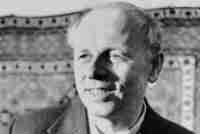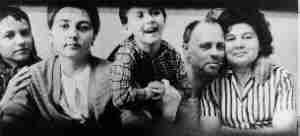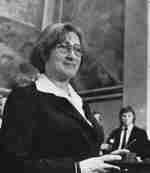 SKC Films Library SKC Films Library |
| SKC Films Library >> Science >> Physics >> Biography |
 Andrei
Sakharov Andrei
Sakharovco-developer of the Soviet Union's first hydrogen bomb Andrei Dmitriyevich Sakharov was born in Moscow on May 21, 1921. His father was a teacher of physics and author of textbooks, exercise books and works of popular science who often demonstrated physics experiments at home. Andrei taught himself to read at age four, and learned English by listening to his grandmother read English works of fiction in the original (she had taught English to herself). He did not attend school until seventh grade, but took his final school examination with distinction in 1938. Sakharov was attending Moscow State University when World War II broke out, and only missed out on military service by failing the physical exams. Despite the university having to evacuate to central Asia in October 1941, and being seriously short on qualified faculty and equipment, Sakharov graduated with honors in 1942. Declining an opportunity to go to graduate school, Sakharov was sent to a munitions factory on the Volga in September 1942, where he worked as an engineer and inventor until 1945. There he made a number of inventions in the field of production control at factory. He also wrote several scientific articles on theoretical physics, but none were never published. In 1943 he met and married Klavdia Vikhireva, a laboratory technician at the factory. In 1945 Sakharov entered P.N. Lebedev Institute, where he studied under theoretical physicist Igor Evgenyevich Tamm, and received his doctorate in physics in 1947. Work on Hydrogen Bomb In 1948 Tamm was chosen to work on the Soviet Union's hydrogen bomb program, and Sakharov joined him, first in Moscow, and then in a special secret research center. Tamm and Sakharov's research led to detonation of the first Soviet hydrogen bomb on August 12, 1953. Sakharov was rewarded for his role in the program with membership in the Academy of Sciences of the Soviet Union, the first of three Hero of Socialist Labor Medals, the Stalin Prize, and a luxurious country house. He subsequently assumed Tamm's position at the research center and made key contributions to the Soviet Union's first full-fledged H-bomb, tested in 1955. Denouncement of "Clean Bombs" In 1957 Sakharov was asked to write an article denouncing American development of a "clean bomb" that would leave less radioactive debris. In the article, he used biological data to calculate that detonation of a one-megaton "clean bomb" would produce enough radiactive carbon to cause 6,600 deaths worldwide over a period of 8,000 years. He also wrote two papers, Radioactive Carbon from Nuclear Explosions and Nonthreshold Biological Effects and The Radiactive Danger of Nuclear Tests, in which he disputed all notions that tests of any nuclear weapons were safe. His article and papers were published in 1958, just after the Soviet Union announced a moratorium on testing. First Protests In July 1961 Soviet Prime Minister Nikita Khrushchev decided to revoke the moratorium on testing. Although Sakharov openly protested the tests, he agreed to help develop the "Tsar Bomb," which became the most powerful device ever exploded on earth on October 30, 1961. Sakharov had been assured by Khrushchev that the test was necessary and that it would be the Soviet Union's last, but he soon learned that he had been deceived. On September 25, 1962, after learning that another hydrogen bomb test had been scheduled, he personally phoned Khrushchev in protest, saying "the test is pointless" and that "it will kill people for no reason." Despite Khrushchev's assurances that he would see about postponing the test, it went off the next day. From this time forward Sakharov all but gave up his physics research to speak out against nuclear war and the communist dictatorship, what he considered the two greatest threats to civilization. Censure In 1967 Sakharov prepared a secret memorandum advising the Soviet leadership to accept an American proposal for a moratorium on anti-ballistic missile (ABM) defenses. It was his fervent belief that any possibility of defense against the possibility of Mutual Assured Destruction (MAD) all but cancelled out the deterrence offered by such assurance -- in other words, it was better for peace to be worried about MAD than believe yourself safe from attack. He prepared an article on the issue, but Soviet leaders deemed it "unsuitable for publication." In May 1968 Sakharov wrote Progress, Peaceful Coexistence and Intellectual Freedom, in which he stated that the threat of thermonuclear war was a direct result of ABMs. He also harshly criticized the lack of freedoms in the Soviet Union. The article was circulated in several typewritten copies, and published by the Dutch newspaper Het Porool and by the New York Times in July. In response, the Soviet government removed Sakharov from his top-secret work and relieved him of his privileges in the Soviet Nomenclatura (privileged class) in July 1968.
left: only known picture of Andrei, Klavdia, and their three children Nobel Peace Prize Although Sakharov initially seemed content to be back doing research, that contentment didn't last long. He still had the same strong beliefs regarding the restrictions seemingly inherent in a Communist society, so in 1970 he, along with Valery Chalidze and Andrei Tverdokhlebov, founded the Moscow Human Rights Committee. It was in this movement that he met Elena Bonner, whom he married in 1971. Bonner worked with him on articles, interviews, appeals, and demonstrations in defense of victims of political persecution and discrimination. Sakharov's articles didn't sit well with the Soviet authorities. In 1973 the Soviet press began publishing articles and editorials, some signed by members of Soviet Academy of Sciences, denouncing him, and Soviet officials began keeping close tabs on his comings and goings.
left: Elena Bonner accepting Sakharov's Nobel Peace Prize Exile in Gorky In 1980 Sakharov publicly denounced the Soviet invasion of Afghanistan. On January 22 he was picked up by Soviet authorities and exiled to Gorky. He was joined by Bonner, also under sentence of exile, in 1984. Although his movements and activities were strictly monitored, he was able to receive reprints of scientific articles by Western physicists, who also campaigned in the media for his release. He was also able to smuggle some essays out which were published in the Western press. Sakharov spent six years in exile, during which time his family was harassed and persecuted by Soviet authorities. He and Elena went on a 200-day hunger strike at one point in protest. The emotional strain of exile, combined with the prolonged hunger strike, placed a severe physical strain on Elena's health, and in 1985 the Soviet Union allowed her to leave the country in order to undergo heart surgery. Post-Exile Sakharov's exile finally came to an end in December 1986, thanks to Mikhail Gorbachev's policies of liberalization. He returned to Mosocw, where he helped initiate the first independent legal political organizations of the intelligentsia. Although these organizations advocated more radical democratic changes than the Communist Party was willing to make, Gorbachev's new policies meant that they could actually voice their opinions without risking government retribution. Elected to the newly-formed Congress of People's Deputies in April 1989, Sakharov was the leading spokesman for human rights and economic and political reform until a heart attack took his life on December 14, 1989. His Writings Progress, Peaceful Coexistence and
Intellectual Freedom (1968) SOURCES SEE ALSO |
| SKC Films Library
>> Science >> Physics >> Biography This page was last updated on 06/11/2017. |
 Sakharov's wife died of cancer in March 1969,
leaving him with three children, aged 24, 19, and 11. In
May he returned to the Lebedev Institute to work in pure
theoretical physics.
Sakharov's wife died of cancer in March 1969,
leaving him with three children, aged 24, 19, and 11. In
May he returned to the Lebedev Institute to work in pure
theoretical physics. In 1975 Sakharov was awarded the
In 1975 Sakharov was awarded the